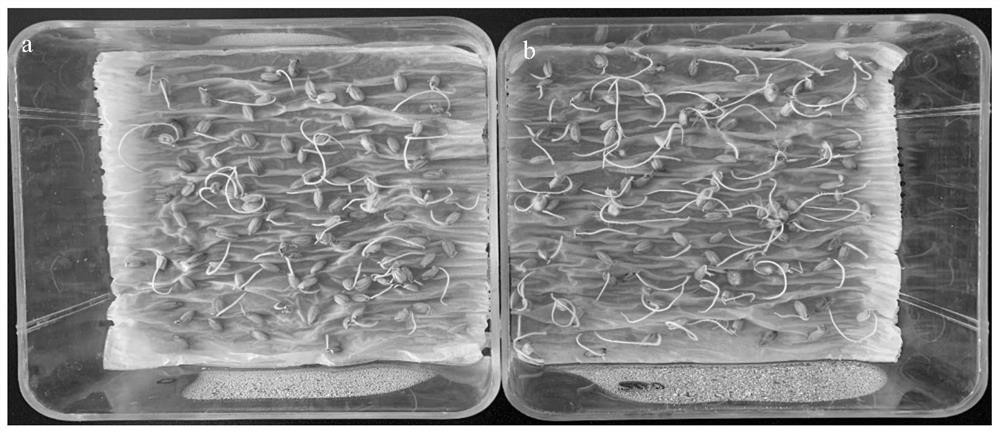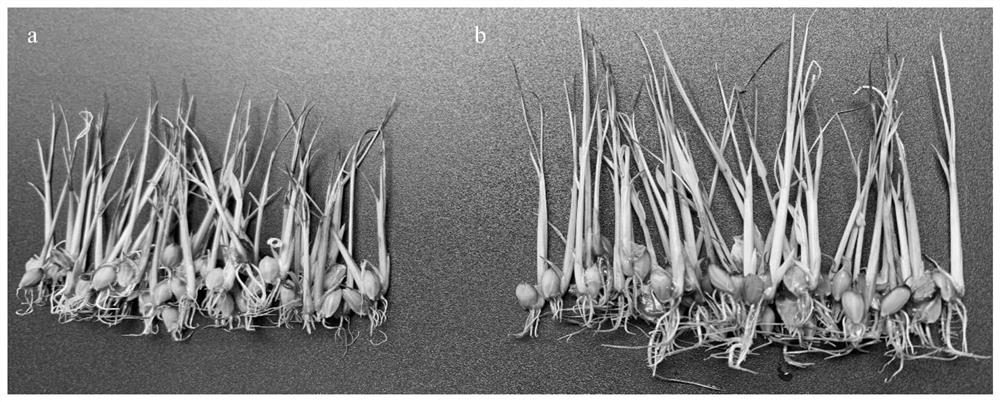Method for inducing rice to improve salt tolerance
A technology of salt tolerance and rice, applied in the field of inducing rice to improve salt tolerance, can solve the problems of slow growth, poor quality, low seedling emergence rate, etc. Effect
- Summary
- Abstract
- Description
- Claims
- Application Information
AI Technical Summary
Problems solved by technology
Method used
Image
Examples
Embodiment 1
[0022] A method for inducing rice to improve salt tolerance, the steps are as follows:
[0023] Step 1. Disinfect the surface of rice seeds, and then dissolve 5-hydroxynorvaline with 3 wt.‰NaCl solution to prepare a 5-hydroxynorvaline solution with a concentration of 20 mg / L. The specific process of surface disinfection of rice seeds As follows: select mature rice seeds with plump grains and no mold spots, rinse twice with 70 wt.% ethanol solution for 30 s each time, rinse twice with sterile water, and then sterilize with 5 wt.% NaClO solution for 5 min , rinsed with sterile water for 3 times, and finally blotted the water attached to the surface of the seeds with sterile filter paper;
[0024] Step 2. Soak the rice seeds with the 5-hydroxynorvaline solution prepared in step 1 for 16 hours at 20° C. to obtain treated rice seeds, and allow them to germinate and grow normally under salt stress. The salt stress environment is a mixed solution of 5-hydroxyl-L-norvaline and NaCl, ...
Embodiment 2
[0027] A method for inducing rice to improve salt tolerance, the steps are as follows:
[0028] Step 1. Disinfect the surface of rice seeds, and then dissolve 5-hydroxynorvaline with 10 wt.‰NaCl solution to prepare a 5-hydroxynorvaline solution with a concentration of 400 mg / L. The specific process of surface disinfection of rice seeds As follows: select mature rice seeds with plump grains and no mold spots, rinse them with 75 wt.% ethanol solution for 3 times, each time for 40 s, rinse with sterile water for 3 times, and then sterilize with 10 wt.% NaClO solution for 15 min , rinsed with sterile water for 5 times, and finally blotted the water attached to the seed surface with sterile filter paper;
[0029]Step 2. Soak the rice seeds with the 5-hydroxynorvaline solution prepared in step 1 for 24 hours at 28° C. to obtain treated rice seeds, and allow them to germinate and grow normally under salt stress. The salt stress environment is a mixed solution of 5-hydroxyl-L-norvali...
Embodiment 3
[0032] A method for inducing rice to improve salt tolerance, the steps are as follows:
[0033] Step 1. Disinfect the surface of rice seeds. The specific process of surface disinfection of rice seeds is as follows: select mature rice seeds with full grains and no mold spots, rinse them with 70 wt.% ethanol solution twice, each time for 30 s, and rinse with sterile water 2 times, then sterilized with 5wt.% NaClO solution (plus 1-2 drops of Tween 20) for 5 min, rinsed with sterile water for 3-5 times, and finally blotted the water attached to the seed surface with sterile filter paper, and then used 5 wt. .‰NaCl solution dissolves 5-hydroxyl-L-norvaline to prepare a 5-hydroxyl-L-norvaline solution with a concentration of 200 mg / L;
[0034] Step 2. Soak the rice seeds with the 5-hydroxy-L-norvaline solution prepared in step 1 for 24 hours at 25° C. to obtain treated rice seeds, and allow them to germinate and grow normally under salt stress. The salt stress environment is irriga...
PUM
| Property | Measurement | Unit |
|---|---|---|
| Concentration | aaaaa | aaaaa |
Abstract
Description
Claims
Application Information
 Login to View More
Login to View More - R&D
- Intellectual Property
- Life Sciences
- Materials
- Tech Scout
- Unparalleled Data Quality
- Higher Quality Content
- 60% Fewer Hallucinations
Browse by: Latest US Patents, China's latest patents, Technical Efficacy Thesaurus, Application Domain, Technology Topic, Popular Technical Reports.
© 2025 PatSnap. All rights reserved.Legal|Privacy policy|Modern Slavery Act Transparency Statement|Sitemap|About US| Contact US: help@patsnap.com


